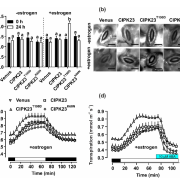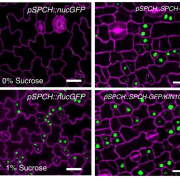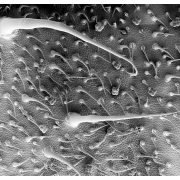Helping out a neighbor: What FAMA tells us about specialization among stomatal genes across different species
Author et al. explore the genes involved in making stomata in a temperate grass.
Katelyn Hansen-McKown and Dominique Bergmann, Stanford University School of Medicine, Stanford University and Howard Hughes Medical Institution.
Background: Plants are essential players in global carbon and water cycling. The structures central to this role are stomata, pores on leaf surfaces. Plants open and close their stomata depending on environmental conditions to regulate gas exchange, and can adjust the number of stomata they make. Tuning stomatal numbers and activity can improve water use efficiency and drought tolerance. Typically, two guard cells flank a stomatal pore, but grasses have additional subsidiary cells flanking each guard cell, making their stomata even better at responding to environmental cues. What genes are involved in creating such magnificent stomata?
Question: We knew that homologues of three stomatal genes first found in Arabidopsis–SPCH, MUTE, and FAMA–were in other plants, and that SPCH and MUTE could take on unexpected roles across species. The sequence of FAMA from Brachypodium distachyon, a relative of wheat, differs in intriguing ways from Arabidopis FAMA, so we asked what roles BdFAMA plays in Brachypodium stomatal development.
 Findings: BdFAMA promotes guard cell fate in the final step of stomatal development, but unexpectedly, is “on” much earlier, overlapping with the preceding gene, BdMUTE. Other grasses die without MUTE activity, but in Brachypodium, this earlier expression of BdFAMA can compensate for the absence of MUTE. In Arabidopsis, BdFAMA function can replace both MUTE and FAMA, but cannot rescue myrosin cells, a specialized cell type in the Brassica family. So, some of FAMA’s roles are the same across different plants with unique stomata, but other roles have species-specific nuances.
Findings: BdFAMA promotes guard cell fate in the final step of stomatal development, but unexpectedly, is “on” much earlier, overlapping with the preceding gene, BdMUTE. Other grasses die without MUTE activity, but in Brachypodium, this earlier expression of BdFAMA can compensate for the absence of MUTE. In Arabidopsis, BdFAMA function can replace both MUTE and FAMA, but cannot rescue myrosin cells, a specialized cell type in the Brassica family. So, some of FAMA’s roles are the same across different plants with unique stomata, but other roles have species-specific nuances.
Next steps: To improve crops, we need to understand how plant cells and organs are made and specialized. This work in the temperate grass Brachypodium provides a framework that future scientists can use to connect environmental signals to stomatal development and regulation and contribute to improving agriculturally significant grasses like wheat and barley.
Katelyn H. McKown, M. Ximena Anleu Gil, Andrea Mair, Shou-Ling Xu, Michael T. Raissig, and Dominique C. Bergmann (2023) Expanded roles and divergent regulation of FAMA in Brachypodium and Arabidopsis stomatal development. https://doi.org/10.1093/plcell/koac341









